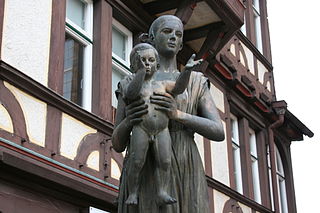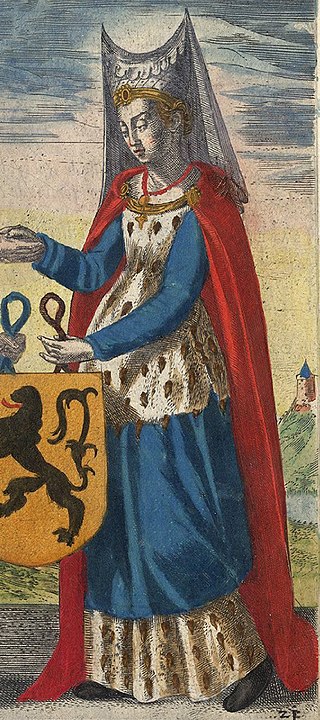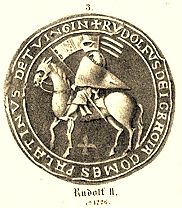
Conrad, a member of the Hohenstaufen dynasty, was the only son of Emperor Frederick II from his second marriage with Queen Isabella II of Jerusalem. He inherited the title of King of Jerusalem upon the death of his mother in childbed. Appointed Duke of Swabia in 1235, his father had him elected King of Germany and crowned King of Italy in 1237. After the emperor was deposed and died in 1250, he ruled as King of Sicily until his death.
A count palatine, also count of the palace or palsgrave, was originally an official attached to a royal or imperial palace or household and later a nobleman of a rank above that of an ordinary count. The title originated in the Late Roman Empire. In the Middle Ages especially and into modern times, it is associated with the Holy Roman Empire, especially Electoral Palatinate.

Wenceslaus I, called One-Eyed, was King of Bohemia from 1230 to 1253.

Henry I of Hesse "the Child" was the first Landgrave of Hesse. He was the son of Henry II, Duke of Brabant and Sophie of Thuringia.

Leopold VI, known as Leopold the Glorious, was Duke of Styria from 1194 and Duke of Austria from 1198 to his death in 1230. He was a member of the House of Babenberg.

Conrad was the landgrave of Thuringia from 1231 to 1234 and the fifth Grand Master of the Teutonic Order from 1239 to 1240. He was the first major noble to join the military order.

Hermann I, Landgrave of Thuringia and Count Palatine of Saxony, was the second son of Louis II, Landgrave of Thuringia, and Judith of Hohenstaufen, the sister of Emperor Frederick Barbarossa.

Henry (VII) (1211 – 12 February 1242), a member of the Hohenstaufen dynasty, was King of Sicily from 1212 until 1217 and King of Germany (formally Rex Romanorum) from 1222 until 1235, as son and king, co-ruler of Emperor Frederick II. He was the seventh Henry to rule Germany, but in order to avoid confusion with the Luxembourg emperor Henry VII, he is usually numbered Henry (VII).

Henry III, called Henry the Illustrious from the House of Wettin was Margrave of Meissen and last Margrave of Lusatia from 1221 until his death; from 1242 also Landgrave of Thuringia.

Louis IV the Saint, a member of the Ludovingian dynasty, was Landgrave of Thuringia and Saxon Count palatine from 1217 until his death. He was the husband of Elizabeth of Hungary.

The Ludovingians or Ludowingians were the ruling dynasty of Thuringia and Hesse during the 11th to 13th centuries.

Sophie of Thuringia was the second wife and only Duchess consort of Henry II, Duke of Brabant and Lothier. She was the heiress of Hesse which she passed on to her son, Henry upon her retention of the territory following her partial victory in the War of the Thuringian Succession in which she was one of the belligerents. Sophie was the founder of the Brabant dynasty of Hesse.
The Duchy of Thuringia was an eastern frontier march of the Merovingian kingdom of Austrasia, established about 631 by King Dagobert I after his troops had been defeated by the forces of the Slavic confederation of Samo at the Battle of Wogastisburg. It was recreated in the Carolingian Empire and its dukes were appointed by the king until it was absorbed by the Saxon dukes in 908. From about 1111/12 the territory was ruled by the Landgraves of Thuringia as Princes of the Holy Roman Empire. When Frederick IV, the last independent ruler of Thuringia died in 1440, the territory passed to his nephew, the Saxon elector Frederick II.
Elisabeth of Brandenburg a member of the House of Ascania. She was a Margravine of Brandenburg by birth and by marriage Landgravine of Thuringia.

Beatrice of Brabant, was a Landgravine consort of Thüringia and a Countess consort of Flanders, married first to Henry Raspe, Landgrave of Thuringia, and later to William II, Count of Flanders.

Rudolph II, Count Palatine of Tübingen was Count Palatine of Tübingen and Vogt of Sindelfingen. He was the younger son of Rudolph I and his wife Matilda of Gleiberg, heiress of Giessen.
The siege of Aachen, which lasted from late April or early May until October 1248, was part of the German civil war that began with Pope Gregory IX's proclamation of a crusade against the Emperor Frederick II in 1240. The city of Aachen, which was the traditional coronation site of German kings, supported Frederick II and refused to allow his rival, Count William II of Holland, to enter the city to be crowned. William and his supports besieged the city, forcing it to allow him in, where he was crowned German king.
The crusade against the Hohenstaufen was a series of wars launched against the rulers of the Hohenstaufen dynasty with the support and encouragement of the Papacy between 1240 and 1268. The campaigns followed the excommunication of Frederick II, Holy Roman Emperor, in 1239 and ended with the death of his grandson Conradin, a claimant to the Kingdom of Sicily.













